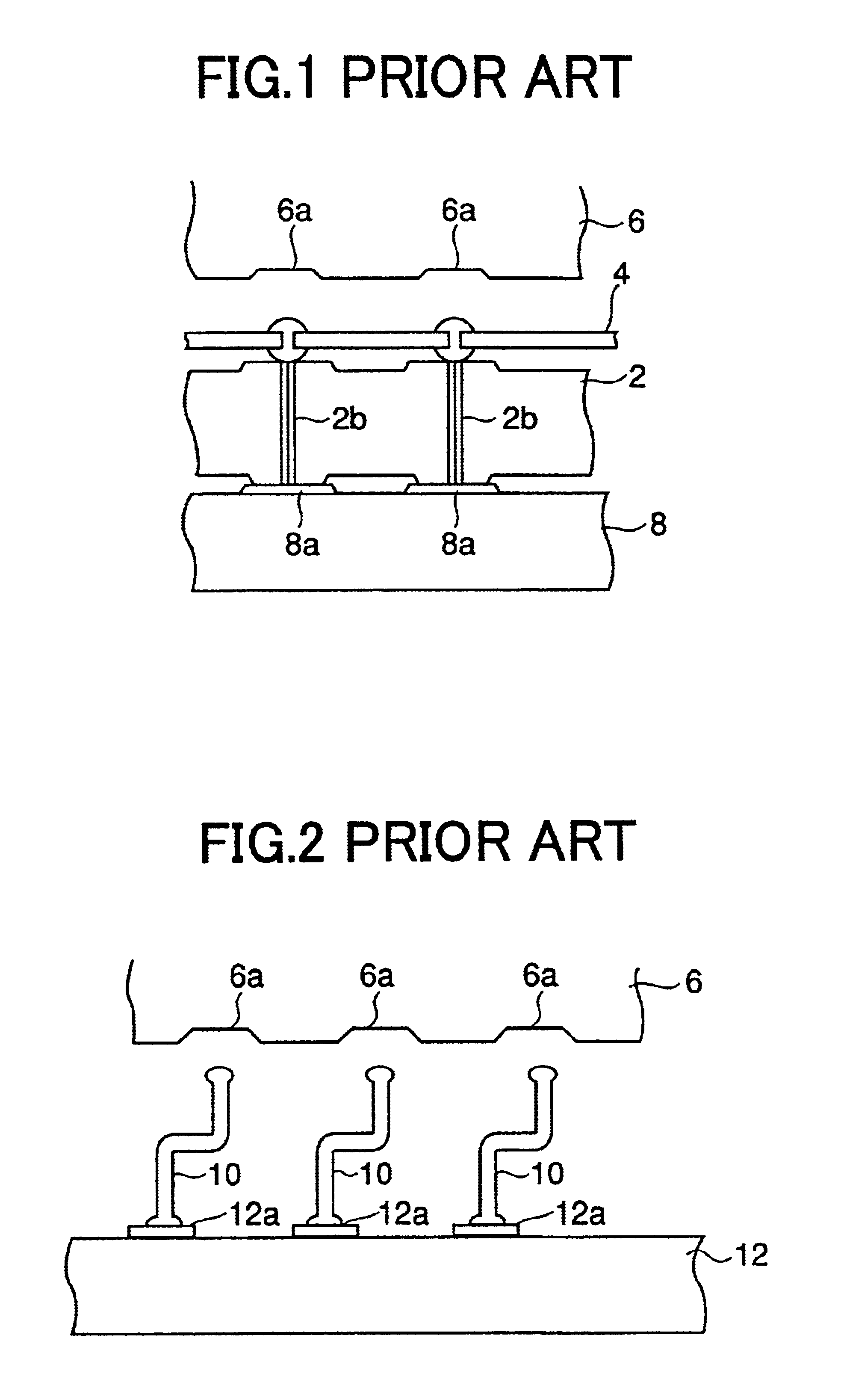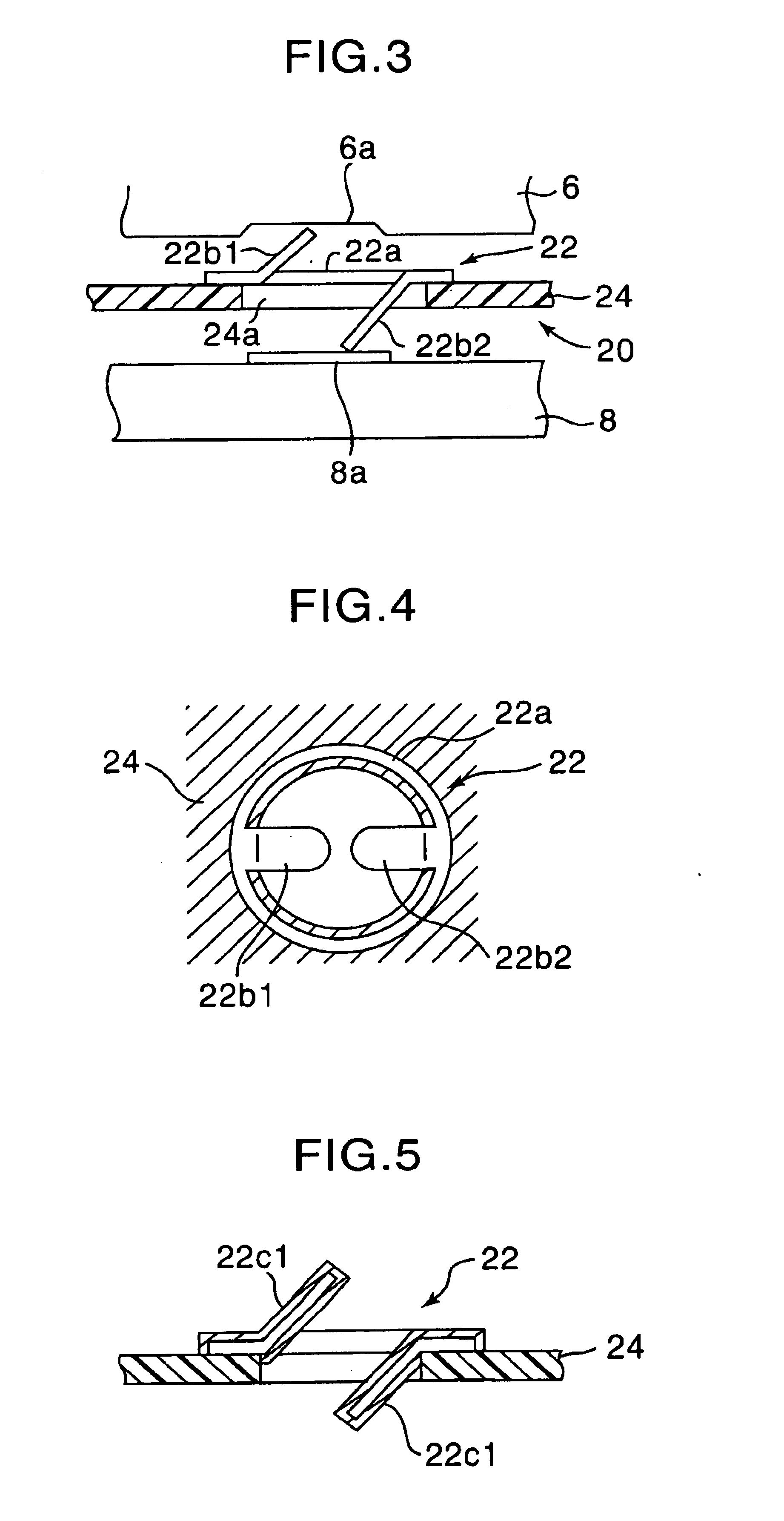Semiconductor device testing contactor having a circuit-side contact piece and test-board-side contact piece
a technology of contactor and semiconductor, which is applied in the direction of semiconductor/solid-state device testing/measurement, coupling device connection, instruments, etc., can solve the problems and high cost of contactor, and achieve the effect of short life duration, short life duration and high cos
- Summary
- Abstract
- Description
- Claims
- Application Information
AI Technical Summary
Benefits of technology
Problems solved by technology
Method used
Image
Examples
second embodiment
[0138]Next, a description will be given, with reference to FIG. 13, of the second embodiment according to the present invention.
[0139]FIG. 13 is a cross-sectional view of a contact electrode 32 of a contactor according to the second embodiment of the present invention. An entire structure of the contactor is the same as the above-mentioned contactor 20 according to the first embodiment, so a description thereof will be omitted.
[0140]The contact electrode 32 shown in FIG. 13 is formed after a copper plate or a copper foil is applied on both surfaces of the insulating substrate 24. The contact electrode 32, as the contact electrode 22, has an annular portion 32a and an LSI-circuit-side contact piece 32b1. The annular portion 32a and the LSI-circuit-side contact piece 32b1 are formed of a copper plate or a copper foil applied on one side (the LSI circuit 6's side) of the insulating substrate 24. Accordingly, the annular portion 32a and the LSI-circuit-side contact piece 32b1 are formed...
third embodiment
[0145]The contact electrode 42 with an annular portion 42a, shown in FIG. 14, according to the present invention is a contact electrode adapted to a case where a terminal of the LSI circuit 6 is a protruding electrode 6b such as a solder bump (shown in FIG. 16). In order to prevent an LSI-circuit-side contact piece 42b1 from undergoing a permanent deformation due to a contact pressure with the solder bump 6b, the two LSI-circuit-side contact pieces 42b1 are juxtaposed on both sides of a central piece 42b2 and a centerline of the solder bump 6b, avoiding the center of the solder bump 6b. In FIG. 15, the LSI-circuit-side contact piece 42b1 is level, not bent toward the LSI circuit 6.
[0146]FIG. 16 is a cross-sectional view of the contact electrode 42 placed between the LSI circuit 6 and the test board 8. The LSI-circuit-side contact pieces 42b1, pressed by the solder bump 6b, are elastically deformed toward the test board 8, bent into the opening 24a. This elastic deformation provides ...
first embodiment
[0149]As the contact electrode 22 according to the present invention, the contact electrode 52 shown in FIG. 18 has an annular portion 52a, an LSI-circuit-side contact piece 52b1 and a test-board-side contact piece 52b2. However, the contact electrode 52 according to the present embodiment is formed as follows: forming an opening 24b having a shape corresponding to a shape of the contact electrode 52 in the insulating substrate 24 in advance; and forming a conductive film around a periphery of the opening 24b by such a method as plating or sputtering. That is, the contact electrode 52 itself is formed by such a method as plating or sputtering.
[0150]FIGS. 19A, 19B, and 19C illustrate steps of forming the contact electrode 52. First, as shown in FIG. 19A, the opening 24b having the shape corresponding to the shape of the contact electrode 52 is formed in the insulating substrate 24. Since the insulating substrate 24 is formed of such a resin sheet as a polyimide resin sheet, the openi...
PUM
| Property | Measurement | Unit |
|---|---|---|
| temperature | aaaaa | aaaaa |
| thick | aaaaa | aaaaa |
| heights | aaaaa | aaaaa |
Abstract
Description
Claims
Application Information
 Login to View More
Login to View More - R&D
- Intellectual Property
- Life Sciences
- Materials
- Tech Scout
- Unparalleled Data Quality
- Higher Quality Content
- 60% Fewer Hallucinations
Browse by: Latest US Patents, China's latest patents, Technical Efficacy Thesaurus, Application Domain, Technology Topic, Popular Technical Reports.
© 2025 PatSnap. All rights reserved.Legal|Privacy policy|Modern Slavery Act Transparency Statement|Sitemap|About US| Contact US: help@patsnap.com



